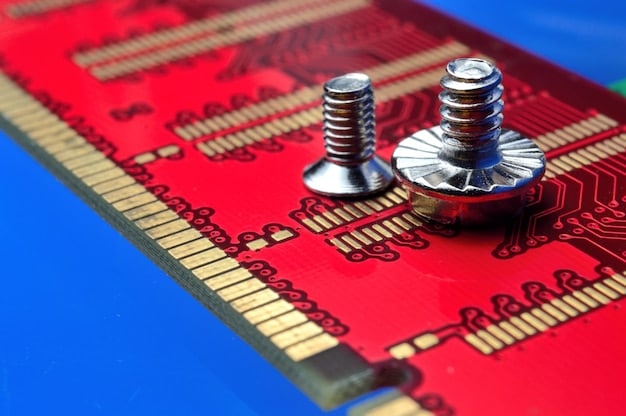How to Recycle Electronics and Reduce E-Waste in 2025: A Comprehensive Guide

Properly recycling electronics and reducing e-waste in 2025 involves understanding evolving regulations, utilizing certified recycling centers, repairing devices, donating functional electronics, and advocating for sustainable practices to minimize environmental impact.
The ever-increasing consumption of electronic devices contributes significantly to electronic waste, or “e-waste,” a growing environmental concern. Learning how to properly recycle electronics and reduce e-waste in 2025 is no longer just a suggestion, but a necessity for a sustainable future.
Understanding the E-Waste Problem in 2025
Electronic waste represents one of the fastest-growing waste streams worldwide. Understanding the scope of the problem is the first step toward contributing to solutions. This section will explore the key issues surrounding e-waste in 2025.
The Sheer Volume of E-Waste
By 2025, the amount of e-waste generated globally will reach unprecedented levels. This includes everything from smartphones and laptops to household appliances and entertainment systems. The sheer volume poses logistical challenges for collection, processing, and responsible disposal.
Environmental and Health Impacts
Improperly discarded electronics can leach harmful substances into the environment, contaminating soil and water sources. These substances, such as lead, mercury, and cadmium, pose significant health risks to both humans and ecosystems. Effective recycling practices are essential to mitigating these dangers.

We can reduce the environmental and health impact of e-waste by:
- Prioritizing certified recycling centers that adhere to strict environmental standards.
- Encouraging manufacturers to design products with recyclability in mind, minimizing hazardous materials.
- Supporting policies and regulations that promote responsible e-waste management on a global scale.
Acknowledging the volume and harm caused by e-waste sets the stage for actionable solutions, including adopting responsible recycling practices.
Updated E-Waste Recycling Regulations and Standards in 2025
Staying informed about current regulations and standards is crucial for ensuring electronics are recycled responsibly. This part will dive into recent updates and highlight organizations that set the benchmark for eco-friendly practices.
Key Regulatory Updates
As environmental awareness grows, so do the regulations governing e-waste disposal. In 2025, many countries have implemented stricter guidelines on the collection, transportation, and processing of electronic waste. Check with your local environmental protection agency for the most up-to-date information.
Role of Certifying Organizations
Organizations like R2 (Responsible Recycling) and e-Stewards provide certification to recycling facilities that meet high standards for environmental protection and worker safety. Choosing certified recyclers ensures that your e-waste is handled responsibly.
Compliance with latest regulations and use of certified organizations is important because:
- Certification guarantees that e-waste is managed responsibly, with toxic materials handled properly.
- Adherence to regulations minimizes environmental risks, such as soil and water contamination.
- Knowing the latest standards helps individuals and businesses stay compliant and avoid penalties.
By keeping up with the regulatory landscape and relying on certified organizations, you’re taking active steps to ensure your e-waste contributes to a more sustainable future.
Finding Certified E-Waste Recycling Centers Near You
Locating accessible and certified e-waste recycling centers is a pivotal step in ensuring your electronics are processed responsibly. This section provides actionable tips on where to search and what to look for when selecting a recycling center.
Online Search Tools and Databases
Several online resources can help you find certified e-waste recycling centers in your area. Websites of organizations like R2 and e-Stewards often have searchable databases. Additionally, your local government’s waste management department may provide a list of approved facilities.
Community Collection Events
Participating in community electronic waste collection events is another convenient way to recycle your old devices. These events are often organized by local governments, schools, or community organizations, providing an easy drop-off option for residents.

To confirm trustworthiness of e-waste recycling centers ensure that:
- The recycling center is certified by a reputable organization (e.g., R2, e-Stewards).
- The center transparently explains its recycling processes and environmental policies.
- The facility has a good track record, with positive reviews and no major compliance issues.
Having access to reputable recycling centers streamlines the process of responsible e-waste management, empowering individuals and communities to act sustainably.
Extending the Life of Your Electronics: Repair and Maintenance
Extending the lifespan of your electronic devices is the first step in reducing e-waste. Repairing and maintaining electronics can save money and resources, contributing to a more sustainable environment. This section will offer practical maintenance tips and highlight the benefits of repairing over replacing.
Simple Maintenance Tips
Regular maintenance can prolong the life of your devices significantly. For computers, this includes cleaning out unnecessary files, updating software, and defragmenting hard drives. For mobile devices, use protective cases, screen protectors, and avoid exposing them to extreme temperatures.
The Benefits of Repairing Over Replacing
Before automatically replacing a broken device, consider the possibility of repair. Repairing your electronics is often more cost-effective and environmentally friendly than buying new ones. It reduces the demand for new resources and lowers the amount of e-waste generated.
Repairing and maintenance has important benefits:
- Prolonging the life of electronics reduces the need for frequent replacements.
- It saves money by avoiding the cost of buying new devices.
- It lowers the environmental impact associated with manufacturing and disposing of electronics.
By adopting proactive maintenance practices and considering repair options, consumers can significantly reduce their contribution to the e-waste stream and promote a culture of sustainability.
Donating or Selling Used Electronics Responsibly
When your electronics are still functional but no longer needed, consider donating or selling them responsibly. Doing so gives your devices a second life and reduces e-waste. This section outlines how to find suitable donation options and ensure responsible reselling.
Finding Suitable Donation Options
Many charitable organizations accept donations of used electronics, providing them to individuals and communities in need. Local schools, libraries, and community centers often welcome donations of computers, tablets, and other devices. Ensure that all your personal data is securely wiped before donating.
Ensuring Responsible Reselling
If your electronics are still in good working condition, you can also sell them through online marketplaces or local classifieds. When reselling, be honest about the device’s condition and provide accurate descriptions. Also, be sure to securely erase all personal data before handing it over to the buyer.
To responsibly donate or sell used electronics:
- Always wipe your personal data from devices you plan to donate or sell.
- Choose reputable organizations or marketplaces for donation/resale.
- Ensure devices are still functional and useful to potential recipients.
Donating or selling old electronics responsibly not only reduces waste but also provides opportunities for others to access technology and bridge the digital divide.
Advocating for Sustainable E-Waste Practices
Individual actions, combined with broad systemic changes, are vital for addressing the e-waste crisis. Advocate for policies and business practices that prioritize sustainability can amplify the impact of responsible e-waste management. This section explores corporate responsibility and how you can promote sustainable e-waste solutions.
Promoting Corporate Responsibility
Encourage electronics manufacturers to adopt sustainable design and recycling practices. This includes designing products with longer lifespans, using recyclable materials, and providing take-back programs for end-of-life devices. Support companies that prioritize environmental responsibility.
Supporting Policy Changes
Advocate for policies that promote responsible e-waste management at the local, state, and national levels. This can include supporting legislation that mandates e-waste recycling, establishes standards for recycling facilities, and encourages extended producer responsibility.
Advocating for sustainable e-waste practices enhances the impact of recycling because:
- It encourages companies to become more environmentally responsible.
- It supports policies that mandate responsible e-waste management.
- It raises awareness about the importance of sustainable practices among communities and governments.
By becoming advocates for sustainable e-waste practices, individuals can help drive systemic changes that lead to a more sustainable future.
| Key Point | Brief Description |
|---|---|
| ♻️ Find Certified Centers | Use online tools to locate certified e-waste recycling centers near you. |
| 🛠️ Repair and Maintain | Extend the life of electronics with regular maintenance and consider repair options. |
| 🎁 Donate or Resell | Donate working electronics to charities or resell responsibly. |
| 📣 Advocate for Change | Support sustainable e-waste policies and encourage manufacturers to be responsible. |
FAQ
▼
E-waste includes any discarded electronic devices such as computers, smartphones, TVs, and household appliances. It’s essential to manage these items properly due to their hazardous components.
▼
Recycling e-waste protects the environment by preventing toxic substances from leaking into soil and water. It also allows valuable materials to be recovered and reused, reducing the need for mining.
▼
Look for recyclers certified by organizations like R2 or e-Stewards. These certifications ensure they follow strict environmental and safety standards. You can find certified recyclers through their websites.
▼
Before recycling, wipe all personal data from your devices. Remove SIM cards, memory cards, and any other storage media. Many recyclers offer data destruction services if needed.
▼
Yes, donating is a great option if your devices are still functional. Organizations like local charities and schools often accept electronic donations. Ensure you’ve wiped your data before donating.
Conclusion
As we navigate the evolving landscape of e-waste in 2025, individual actions, coupled with collective advocacy, can pave the way for a more sustainable and responsible future. By staying informed, taking proactive steps, and inspiring others, we can mitigate the environmental impact and promote practices that benefit both our planet and future generations.





